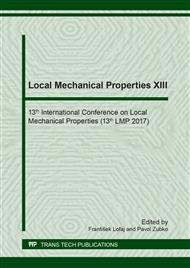[1]
Bažant, Z., Scaling of Structural Strength, second ed., Elsevier Ltd., (2005).
Google Scholar
[2]
Felbeck, D.K., Atkins, A.G., Strength and Fracture of Engineering Solids, Prentice-Hall, New Jersey, (1984).
Google Scholar
[3]
Lawn, B.R., Evans, A.G., Marshall, D.B., Elastic/plastic indentation damage in ceramics: the median/radial crack system. J. Am. Ceram. Soc. 63 (1980), 574–581.
DOI: 10.1111/j.1151-2916.1980.tb10768.x
Google Scholar
[4]
Němeček, J., Hrbek, V., Polívka, L., Jager, A., Combined Investigation of Low-Scale fracture in Hydrated Cement Assessed by Nanoindentation and FIB, Proceedings of the 9th International Conference on Fracture Mechanics of Concrete and Concrete Structures, FraMCoS-9, V. Saouma, J. Bolander and E. Landis (Eds), (2016).
DOI: 10.21012/fc9.244
Google Scholar
[5]
Cheng, Y.T., Li, Z.Y., Cheng, C.M., Scaling relationships for indentation measurements, Philos. Mag. A 82 (2002), 1821–1829.
Google Scholar
[6]
Oliver, W., Pharr, G., An Improved Technique for Determining Hardness and Elastic-Modulus using Load and Displacement Sensing Indentation Experiments, J. Mater. Res. 7 (1992) 1564-1583.
DOI: 10.1557/jmr.1992.1564
Google Scholar
[7]
Němeček, J., Králík, V., Vondřejc, J., Micromechanical analysis of heterogeneous structural materials, Cem Concr Comp 36 (2013), 85-92.
DOI: 10.1016/j.cemconcomp.2012.06.015
Google Scholar
[8]
Gianuzzi, L., Stevie, F., Introduction to Focused Ion Beams. Instrumentation,Theory, Techniques and Practice, Springer, (2005).
Google Scholar
[9]
Němeček, J., Králík, V., Šmilauer V., Polívka L., Jager, A., Tensile strength of hydrated cement paste phases assessed by microbending tests and nanoindentation, Cem Concr Comp 73 (2016) 164-173.
DOI: 10.1016/j.cemconcomp.2016.07.010
Google Scholar
[10]
Němeček, J., Hrbek V., Nanoindentation Assessed Fracture Toughness of Cement Paste, Defect and Diffusion Forum 368 (2016), 186-189.
DOI: 10.4028/www.scientific.net/ddf.368.186
Google Scholar
[11]
Ghebrab, T., Soroushian, P., Mechanical properties of hydrated cement paste: development of structure-property relationships, J. Concr. Struct. Mater. 7 (4) (2010) 37-43.
DOI: 10.4334/ijcsm.2010.4.1.037
Google Scholar
[12]
Bauchy, M., Laubie, H., Qomi, M.A., Hoover, C., Ulm, F.-J., Pelenq, R.-M., Fracture toughness of calcium-silicate-hydrate from molecular dynamics simulations, J. Non Cryst. Solids 419 (2015) 58-64.
DOI: 10.1016/j.jnoncrysol.2015.03.031
Google Scholar


